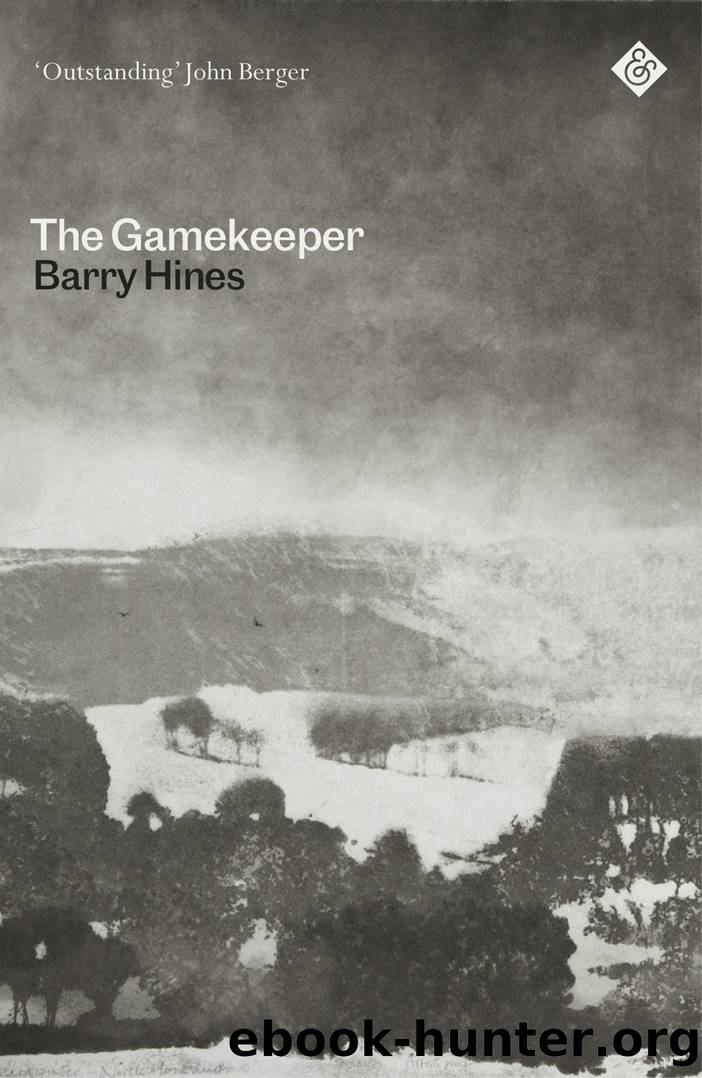The Gamekeeper by Barry Hines

Author:Barry Hines
Language: eng
Format: epub
Tags: Kes;Ken Loach;Class;Hunting;Manor;Birds;Animals;Poachers
Publisher: And Other Stories Publishing
Published: 2022-04-04T15:18:29+00:00
On his way home, the gamekeeper turned in at the gates of the Big House. He wanted some bedding-out plants for his garden. One of the gardeners was raking gravel on the drive. It was no use asking him. He would have to ask Wilf Mott, the Head Gardener. Wilf was always willing to trade a few plants for a couple of rabbits, or the promise of a brace of grouse or pheasant in the season.
As the gamekeeper walked down the drive the gravel crunched under his boots, and he left rough footprints behind him. When the drive had first been laid in the eighteenth century, gravel had been scarce in the district and most paths were made of sand or shale. But the 6th Duke wanted gravel, and loads of it had been transported by sea, canal and road, all the way from Blackheath.
Lawns bordered the drive, and behind the lawns rhododendrons in full flower billowed up to meet the overhang of cedars and beeches planted behind them. The gamekeeper walked down the mauve and crimson corridor, which ended fifty yards away from the House, so that its full frontage could be appreciated on approach. The drive then widened out into a circular forecourt with a fountain in the centre. But there was no water spouting from the dolphinâs mouth, and the pond beneath the boyâs feet was dry.
The gardener raking gravel had not seen Wilf Mott since dinner time, so the gamekeeper carried on across the forecourt. When he reached the fountain, he turned round to ask the gardener something else. But he was too far away, walking up the drive, and it was not important enough to start shouting or walking back for. At the top of the drive, between the gate posts, the tower of the village church formed a third column. The church was a mile away at the other end of the village. At the same time as the drive had been laid, the 6th Duke had had a private road driven straight from the park gates, through the woods and fields to the church, in order to save a detour of two hundred yards, which would have taken him along the village street. It was called the Dukeâs Drive. In the churchyard, the villagers were buried in the common graveyard at one side of the drive, and the Dukeâs family were buried behind railings in a private graveyard at the other.
The gamekeeper walked along the front of the House towards the West Wing. The stone façade had been built in the eighteenth century; the rest of the House was older. There had been a residence on this site since the thirteenth century, but these structures had been knocked down, rebuilt, remodelled and added to, right up to the present House, the earliest parts of which dated back to the sixteenth century. It was a simple façade with pilasters between the windows, and a portico in the centre like an entrance to a Greek temple.
Download
This site does not store any files on its server. We only index and link to content provided by other sites. Please contact the content providers to delete copyright contents if any and email us, we'll remove relevant links or contents immediately.
In Control (The City Series) by Crystal Serowka(35787)
The Wolf Sea (The Oathsworn Series, Book 2) by Low Robert(34698)
We Ride Upon Sticks by Quan Barry(34001)
Crowbone (The Oathsworn Series, Book 5) by Low Robert(33053)
The Book of Dreams (Saxon Series) by Severin Tim(32913)
The Daughters of Foxcote Manor by Eve Chase(23046)
Trainspotting by Irvine Welsh(21023)
Call Me by Your Name by André Aciman(19902)
Shot Through The Heart (Supernature Book 1) by Edwin James(18426)
The Secret History by Donna Tartt(18161)
The Girl from the Opera House by Nancy Carson(15381)
American King (New Camelot #3) by Sierra Simone(14863)
All the Missing Girls by Megan Miranda(14732)
Sad Girls by Lang Leav(13907)
Pimp by Iceberg Slim(13778)
The Betrayed by Graham Heather(12300)
The Betrayed by David Hosp(12203)
4 3 2 1: A Novel by Paul Auster(11790)
Still Me by Jojo Moyes(10785)
